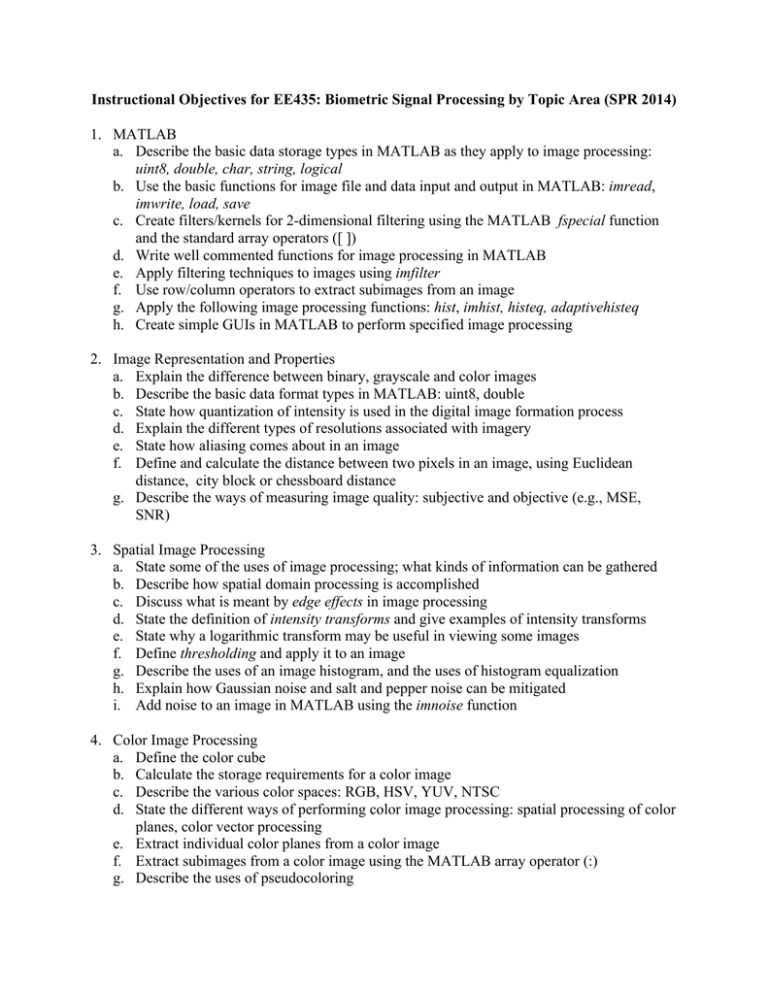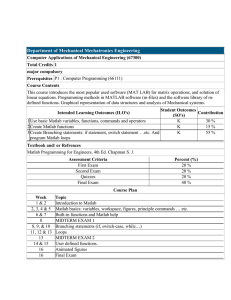Instructional Objectives for EE435: Biometric Signal Processing by Topic Area... 1. MATLAB
advertisement

Instructional Objectives for EE435: Biometric Signal Processing by Topic Area (SPR 2014) 1. MATLAB a. Describe the basic data storage types in MATLAB as they apply to image processing: uint8, double, char, string, logical b. Use the basic functions for image file and data input and output in MATLAB: imread, imwrite, load, save c. Create filters/kernels for 2-dimensional filtering using the MATLAB fspecial function and the standard array operators ([ ]) d. Write well commented functions for image processing in MATLAB e. Apply filtering techniques to images using imfilter f. Use row/column operators to extract subimages from an image g. Apply the following image processing functions: hist, imhist, histeq, adaptivehisteq h. Create simple GUIs in MATLAB to perform specified image processing 2. Image Representation and Properties a. Explain the difference between binary, grayscale and color images b. Describe the basic data format types in MATLAB: uint8, double c. State how quantization of intensity is used in the digital image formation process d. Explain the different types of resolutions associated with imagery e. State how aliasing comes about in an image f. Define and calculate the distance between two pixels in an image, using Euclidean distance, city block or chessboard distance g. Describe the ways of measuring image quality: subjective and objective (e.g., MSE, SNR) 3. Spatial Image Processing a. State some of the uses of image processing; what kinds of information can be gathered b. Describe how spatial domain processing is accomplished c. Discuss what is meant by edge effects in image processing d. State the definition of intensity transforms and give examples of intensity transforms e. State why a logarithmic transform may be useful in viewing some images f. Define thresholding and apply it to an image g. Describe the uses of an image histogram, and the uses of histogram equalization h. Explain how Gaussian noise and salt and pepper noise can be mitigated i. Add noise to an image in MATLAB using the imnoise function 4. Color Image Processing a. Define the color cube b. Calculate the storage requirements for a color image c. Describe the various color spaces: RGB, HSV, YUV, NTSC d. State the different ways of performing color image processing: spatial processing of color planes, color vector processing e. Extract individual color planes from a color image f. Extract subimages from a color image using the MATLAB array operator (:) g. Describe the uses of pseudocoloring h. Implement pseudocoloring of a grayscale image i. Explain how to segment objects from images based on color (color segmentation) 5. Frequency Domain Processing a. Explain the periodicity of the 2D FFT, and why 0 frequency is typically shifted to the center of the 2D FFT after the transform is applied b. Explain the shape of the 2D FFT magnitude for a single rectangular shape c. Interpret the information available in simple 2D FFT images (e.g., the 2D FFT of a periodic sinusoidal waveform image) d. State the steps necessary to perform filtering in the frequency domain e. Create low pass and high pass filters (ideal and Gaussian) f. Perform low pass and high pass filtering of images g. Compare the filtering results when using ideal versus Gaussian filters in terms of ringing and smoothing h. Compare low pass filtered images to determine relative filter cutoff distances i. Compare high pass filtered images to determine relative filter cutoff distances j. View an image to determine if it contains periodic noise, then use a 2D FFT to evaluate the frequency content associated with the periodic noise k. Create band stop filters from low pass and high pass filters to mitigate periodic noise l. Create custom filters to remove or mitigate periodic noise in an image 6. Binary Morphology a. Give examples of how binary images are created b. Describe how a bit plane is formed from a grayscale image c. State the results of the logical AND, OR, XOR and NOT operations on binary values d. Define the term structuring element and state the difference between a structuring element and a filter/kernel e. Describe how erosion is performed on a binary image and its purpose f. Describe how dilation is performed on a binary image and its purpose g. Define the terms opening and closing h. Explain the purpose of skeletonizing a binary image i. Employ binary morphology on binary images using the MATLAB functions strel, imdilate, imerode, bwmorph, imopen, and imclose j. Visually evaluate a set of binary images of the same scene to determine the processing that has been applied to it (thresholding, dilation, erosion, etc.) 7. Image Restoration a. Draw and explain the block diagram that models image degradation b. Define the term point spread function, and state how it can be determined c. Explain the concept of deconvolution and how it is carried out d. Implement deconvolution using Wiener filtering (MATLAB’s deconvwnr function) and blind deconvolution (MATLAB’s deconvblind function) e. Estimate the amount of motion blur in a blurred image, and use deconvolution to restore the image f. Give examples of geometric distortion g. Implement affine transformations in MATLAB h. Define the term image registration and state why it is needed in some applications 8. Segmentation a. Describe how point/line detection is accomplished b. Describe how a Hough transform can detect circles in a binary image c. Discuss the effects of image noise on derivative operators for edge detection, and how to mitigate this with a Laplacian of Gaussian filter (LoG) d. Explain how edge detection is accomplished using Sobel, Laplacian of Gaussian and Canny edge detectors e. Implement edge detection on images using MATLAB’s edge function 9. Pattern/Object Recognition a. Describe how correlation can be used to recognize objects in an image, and the limitations of correlation b. Define the following terms: feature (descriptor), feature extraction, feature (or pattern) vector, model, class, template, decision boundary, separable classes c. Describe the design process for a pattern recognition system d. List what would be considered noise as it pertains to a specific pattern recognition system e. Determine which features from a list may be useful in a pattern recognition application, and which may not be useful f. Create and use a scatter plot to specify decision boundaries (also referred to as discriminants) g. Explain the decision process for unknown pattern vectors h. Explain the concept of a minimum distance classifier i. Use training data to design a pattern recognition algorithm for a multi-class problem j. Determine error performance of a system given a scatter plot and decision boundaries k. Describe the various distance measures between pattern vectors and why weighting distances may be a better measure of distance l. Use the MATLAB functions bwlabel and regionprops on binary images to extract features of detected objects m. Use Bayesian decision theory and a probability tree to determine decision rules, given a priori knowledge 10. Motion Detection/Tracking a. Describe why motion is a powerful cue in extracting objects of interest from a video b. Describe why image registration is important to motion detection c. Explain how thresholding absolute difference between video frames can allow motion detection d. State how noise is handled in the thresholded absolute difference image so that it is not called motion e. Use morphology and the MATLAB function regionprops on binary images to determine and draw a bounding box around detected motion 11. Basics of Biometrics a. Explain what is meant by Identity Management b. Describe the 3 traditional modes of authentication: possessions, knowledge, biometrics c. State the difference between physiological and behavioral biometrics, and give examples of each d. State the difference between verification and identification e. Draw and explain a block diagram of the design process for a biometric recognition system f. Explain the seven characteristics of any biometric that makes it practical: universality, uniqueness, permanence, measurability, performance, acceptability and circumvention g. Describe the three ways that biometrics are used to provide protection: physical access control, logical access control and ensuring uniqueness of individuals h. Describe the six system design parameters for any biometric system: accuracy, computational speed, exception handling, cost, security considerations, privacy of data i. State the difference between positive identification and negative identification, the two types of errors for each, and give examples of where each means of identification are used j. State the three crucial design considerations for a biometric system: sampling/acquisition, similarity function, decision threshold k. Explain the relationship between histograms and probability mass function plots l. Define the following as they relate to system performance: similarity score, imposter, genuine, FMR, FNMR, FAR and FRR, EER, d’ m. Sketch the curves associated with the probability mass functions for match/non-match scores or genuine/imposter scores, and state how a threshold on similarity score is used to adjust system performance n. Identify the FMR/FNMR or FRR/FAR regions of performance curves o. Plot a Receiver Operating Characteristic (ROC) curve for a biometric system, given data for FMR/FNMR or FRR/FAR p. Locate the Equal Error Rate point (EER) on performance curves q. Explain the two general means to improve system performance in terms of the similarity score data for genuine and imposter scores: reduce the standard deviation of the data and/or separating the distributions r. Relate operating points on performance curves to security and convenience 12. Iris Recognition a. Describe the characteristics of an iris that make it so distinctive b. State the name of the person who created the iris recognition algorithm used in most commercial iris systems c. Describe the general steps in the iris recognition process d. Define the terms pupillary boundary, limbic boundary, and scelera e. Explain the purpose of unwrapping an iris image f. Explain the reasons for normalizing the radial extent of an iris g. Describe the purpose of a mask in iris recognition h. Compute the fractional Hamming distance between two iris templates i. List reasons why iris recognition may not work such as significant eyelid obscuration, glare, hard contacts, eye disease/conditions, j. State the advantages and disadvantages of iris recognition compared to other biometrics k. Process data sets of similarity scores to generate iris system performance results 13. Face Recognition a. State the advantages and disadvantages of facial recognition over other biometrics b. State the three most important factors that affect facial recognition performance: pose, illumination, and facial expression c. Describe automatic face processing for facial recognition d. Describe the Eigenface algorithm, including its limitations e. Implement the Eigenface algorithm in MATLAB f. Process data sets of similarity scores to generate face system performance results 14. Fingerprint Recognition a. Given 10 fingerprints, determine the Henry System classification b. Describe the singularity points (core and delta) and visually determine their presence/location in a fingerprint image c. State how orientation fields and the Poincare index is used to determine loops, cores and deltas d. Define minutiae, and visually identify the presence of ridges, bifurcations, ridge endings, lakes/enclosures and islands e. State the parameters used to characterize minutiae: type, relative location, orientation f. Categorize images of the various types of fingerprints as loops, arches, whorls, etc. g. Describe the overall processing of a fingerprint image to determine the location of minutiae: thresholding, morphology, skeletonizing h. Process a skeletonized fingerprint image in MATLAB to locate ridge endings and bifurcations i. Explain how matching is performed between fingerprint images j. Discuss the effects of image quality on fingerprint false accepts and false rejects k. Process data sets of similarity scores to generate fingerprint system performance results 15. Current Issues a. Describe the legal and privacy issues related to the use biometrics. b. Define the term “liveness testing” for biometric systems and give examples. c. State the means to thwart attacks on biometric systems.




